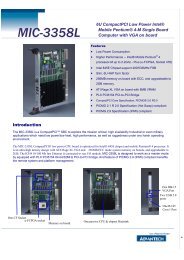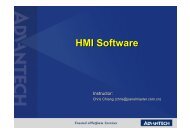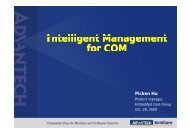industrial wireless book special edition - Networking ...
industrial wireless book special edition - Networking ...
industrial wireless book special edition - Networking ...
Create successful ePaper yourself
Turn your PDF publications into a flip-book with our unique Google optimized e-Paper software.
Fig. 2. WLAN controllers enable<br />
defective access points to be replaced<br />
rapidly and also support and replace<br />
each other<br />
controller's network. The controller then checks<br />
whether the access points have the right<br />
firmware and also sends out configuration data<br />
assigning a logical network position. This saves<br />
the administrator time and effort in putting a<br />
functional network together. During operation,<br />
the controller provides all the necessary information<br />
via the network. For instance, if an<br />
access point fails, the controller immediately<br />
recognises the alternative device as soon as it<br />
is replaced and connects it to the network. The<br />
management software therefore no longer has<br />
to call up the data from each individual access<br />
point. This reduces network load and information<br />
is available more quickly.<br />
In addition, further functions can be provided<br />
which would not be possible without a<br />
complete overview of the network. For example,<br />
controllers can be used to set up the WLAN<br />
network in such a way that channel distribution<br />
results in the fewest possible overlaps and<br />
problems between the access points. As the<br />
controller represents the central access to the<br />
WLAN network, it also becomes the gate keeper<br />
between the wired and <strong>wireless</strong> part of the<br />
network. The controller then provides a firewall<br />
and security function. The devices can also<br />
serve as VPN gateways that can interconnect<br />
several WLAN networks. Moreover, controllers<br />
can also be set to provide redundancy if one of<br />
them fails (Fig. 2).<br />
Controller-compatible access points<br />
WLAN controllers are not economic for small<br />
network use. In this case, there is still a need<br />
for stand-alone access points designed for<br />
<strong>industrial</strong> applications. But if 50 or more of these<br />
devices are used, this investment will certainly<br />
be worthwhile. Industrial access points that can<br />
be managed by WLAN controllers are an<br />
important consideration since enhanced devices<br />
provide a ready made upgrade path should<br />
controller-based operation prove necessary.<br />
In the office sector, controller-supported<br />
networks are currently used mainly for VoIP<br />
where roaming across several sub-networks is<br />
the main benefit. In automation, a WLAN<br />
network rarely has to handle several applications<br />
simultaneously for all the reasons that<br />
one might expect: diagnostics are too complex<br />
and the possible error sources too great. The<br />
main purpose behind the use of a controller<br />
for <strong>industrial</strong> applications would be to ease<br />
network administration.<br />
In addition, client localisation is also<br />
desirable for process automation. This enables<br />
the administrator to see at any time where<br />
personnel with a portable WLAN client are<br />
physically located, whether they are completing<br />
their work in the right place. Controller-based<br />
networks are e<strong>special</strong>ly suitable for such tasks,<br />
as they provide the necessary data centrally.<br />
And finally…<br />
There is an increasingly wide range of WLAN<br />
applications for automation within the context<br />
of networks with a growing complexity. With<br />
the WLAN controllers, it becomes possible to<br />
manage networks with hundreds or thousands<br />
of access points from a central location.<br />
Olaf Schilperoort is with Belden, Inc<br />
First published in the <strong>industrial</strong> ethernet <strong>book</strong> April 2010<br />
Industrial Wireless<br />
sponsored by Advantech<br />
<strong>industrial</strong> ethernet <strong>book</strong><br />
25

















